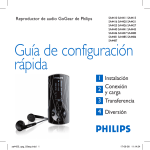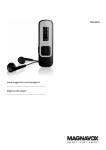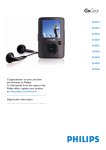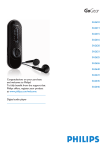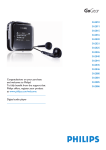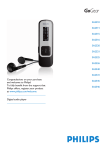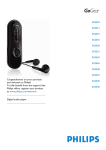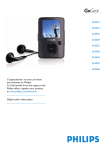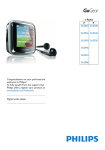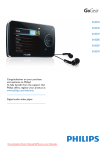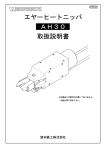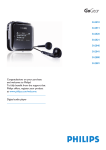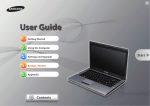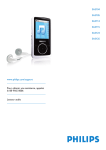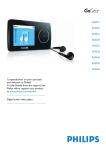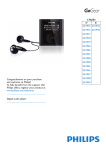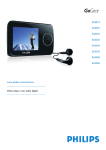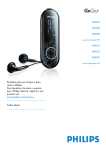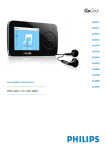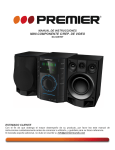Download Philips GOGEAR SA4446 User's Manual
Transcript
SA4415 SA4416 SA4425 SA4426 SA4445 SA4446 SA4485 SA4486 Congratulations on your purchase and welcome to Philips! To fully benefit from the support that Philips offers, register your product at www.philips.com/welcome Digital audio player Need help? Please visit www.philips.com/welcome where you can access a full set of supporting materials such as user manual, the latest software updates and answers to frequently asked questions. ii Contents 1 Important safety information 1 2 Your new player 5 2.1 2.2 3 3.1 3.2 3.3 3.4 3.4.1 3.4.2 3.5 3.5.1 3.6 3.6.1 3.6.2 3.6.3 4 4.1 4.1.1 4.1.2 4.1.3 4.2 4.2.1 4.2.2 4.2.3 4.2.4 4.3 4.3.1 4.3.2 4.3.3 4.4 4.4.1 4.5 1 What’s in the box Register your product Getting started Overview of controls and connections Main menu Install Connect and charge Use the supplied USB cable Battery level indication Transfer Disconnect your player safely Enjoy Turn on and off Navigate the menu Lock slider Detail operation Music mode Control Find your music Limit the volume Radio1 Auto tune radio stations: Play a preset radio station Manual tune a radio station Save a new frequency under a preset Recordings Play recordings Delete your recording Upload recordings to the computer Settings Equalizer custom settings Use your player to store and carry data files 5 5 6 6 7 7 8 8 8 9 9 9 9 9 9 10 10 10 11 11 12 12 12 12 13 14 14 14 14 15 16 16 This feature is available only in some regions. iii Contents 5 5.1 5.2 5.2.1 5.2.2 5.2.3 5.2.4 5.3 5.3.1 5.3.2 5.3.3 5.3.4 5.3.5 5.4 5.4.1 5.4.2 5.4.3 5.4.4 5.5 5.5.1 5.5.2 5.5.3 5.5.4 5.5.5 6 6.1 iv Organize and transfer music with Windows Media Player 11 Installing Windows Media Player 11 (WMP11) Music transfer Add music files to WMP11 library Add music files that are stored elsewhere on your computer or computer network Rip songs from a CD Buy music online Sync your Windows Media contents to your player Set up your player Switch between automatic and manual sync Select and prioritize what syncs automatically Select files and playlists for manual sync Copy files from your player to your computer Manage your Windows Media Player Playlist Create a regular Playlist Create an Auto Playlist Edit playlist Transfer playlists to your player 17 17 17 17 17 19 21 21 22 22 22 24 26 26 26 27 28 29 Manage your files and playlists in Windows Media Player 11 29 Search for music via WMP11 Delete files and playlists from WMP11 library Delete files and playlists from your player Edit song information via WMP11 Format your player via WMP11 Update your player Manually verify software status 29 29 30 31 32 33 33 7 Technical data 34 8 Frequently asked questions 36 1 Important safety information General maintenance To avoid damage or malfunction: • Do not expose the player to excessive heat caused by heating equipment or direct sunlight. • Do not drop your player or allow objects to fall on your player. • Do not allow your player to be submerged in water. Do not expose headphone socket or battery compartment to water, as water entering the set may cause major damage. • Do not use any cleaning agents containing alcohol, ammonia, benzene, or abrasives as these may harm the set. • Active mobile phones in the vicinity may cause interference. • Back up your files. Please ensure that you retain the original files you have downloaded to your device. Philips is not responsible for any loss of data if the product becomes damaged or not readable / legible. • Manage (transfer, delete, etc.) your music files only with the supplied music software to avoid problems! About operating and storage temperatures • Operate in a place where temperature is always between 0 and 35ºC (32 to 95ºF) • Store in a place where temperature is always between -20 and 45ºC (-4 to 113ºF) • Battery life may be shortened in low temperature conditions. Replacement parts/accessories Visit www.philips.com/support to order replacement parts/accessories. Hearing Safety Listen at a moderate volume. • Using headphones at a high volume can impair your hearing. This product can produce sounds in decibel ranges that may cause hearing loss for a normal person, even for exposure less than a minute. The higher decibel ranges are offered for those that may have already experienced some hearing loss. • Sound can be deceiving. Over time your hearing “comfort level” adapts to higher volumes of sound. So after prolonged listening, what sounds “normal” can actually be loud and harmful to your hearing. To guard against this, set your volume to a safe level before your hearing adapts and leave it there. To establish a safe volume level: • Set your volume control at a low setting. • Slowly increase the sound until you can hear it comfortably and clearly, without distortion. Listen for reasonable periods of time: • Prolonged exposure to sound, even at normally “safe” levels, can also cause hearing loss. • Be sure to use your equipment reasonably and take appropriate breaks. 1 Be sure to observe the following guidelines when using your headphones. • Listen at reasonable volumes for reasonable periods of time. • Be careful not to adjust the volume as your hearing adapts. • Do not turn up the volume so high that you can’t hear what’s around you. • You should use caution or temporarily discontinue use in potentially hazardous situations. • Do not use headphones while operating a motorized vehicle, cycling, skateboarding, etc.; it may create a traffic hazard and is illegal in many areas. Important (for models supplied with headphones): Philips guarantees compliance with the maximum sound power of its audio players as determined by relevant regulatory bodies only with the original model of provided headphones. In case this one needs replacement, we recommend that you contact your retailer to order a model identical to that of the original, provided by Philips. Copyright information All other brands and product names are trademarks of their respective companies or organizations. Unauthorized duplication of any recordings whether downloaded from the Internet or made from audio CDs is a violation of copyright laws and international treaties. The making of unauthorized copies of copy-protected material, including computer programmes, files, broadcasts and sound recordings, may be an infringement of copyrights and constitute a criminal offence. This equipment should not be used for such purposes. The Windows Media and the Windows logo are registered trademarks of Microsoft Corporation in the United States and/or other countries. Data logging Philips is committed to improving the quality of your product and enhancing the Philips user experience. To understand the usage profile of this device, this device logs some info / data to the non-volatile memory region of the device. These data are used to identify and detect any failures or problems you as a user may experience while using the device. The data stored, for example, will be the duration of playback in music mode, duration of playback in turner mode, how many times battery low was encountered, etc. The data stored do not reveal the content or media used on the device or the source of downloads. The data stored on the device are retrieved and used ONLY if the user returns the device to the Philips service centre and ONLY to simplify error detection and prevention. The data stored shall be made available to user on user’s first request. 2 Disposal of your old product Your product is designed and manufactured with high quality materials and components, which can be recycled and reused. When this crossed-out wheeled bin symbol is attached to a product, it means the product is covered by the European Directive 2002/96/EC. Please be informed about the local separate collection system for electrical and electronic products. Please act according to your local rules and do not dispose of your old product with your normal household waste. The correct disposal of your old product will help prevent potential negative consequences to the environment and human health. The build-in rechargeable battery contains substances that may pollute the environment. Always hand the appliance in at an official collection point to remove the battery before discarding the appliance. Battery should be disposed of at an official collection point. Modifications Modifications not authorized by the manufacturer may void user authority to operate this device. 3 Notice for USA Note: This equipment has been tested and found to comply with the limits Philips for a Class B digital device, pursuant to part 15 of the FCC Rules. SA4415 SA4416 SA4425 These limits are designed to provide reasonable protection against SA4426 SA4445 SA4446 SA4485 SA4486 harmful interference in a residential installation. This equipment generates, uses, and can radiate radio frequency energy and, if not installed and used in accordance with the instruction manual, may cause harmful interference to radio communications. However, there is no guarantee that interference will not occur in a particular installation. If this equipment does cause harmful interference to radio or television reception, which can be determined by turning the equipment off and on, the user is encouraged to try to correct the interference by one or more of the following measures: - Relocate the receiving antenna. - Increase the separation between equipment and receiver. - Connect the equipment into an outlet on a circuit different from that to which the receiver is connected. - Consult the dealer or an experienced radio/TV technician for help. Notice for Canada This Class B digital apparatus complies with Canadian ICES-003. The set complies with the FCC-Rules, Part 15 and with 21 CFR 1040.10. Operation is subject to the following two conditions: • This device may not cause harmful interference, and • This device must accept any interference received, including interference that may cause undesired operation. Notice for the European Union This product complies with the radio interference requirements of the European Union. 4 2 Your new player With your newly purchased player, you can: • play MP3 and WMA • play FM radio1 • record with built-in microphone 2.1 What’s in the box The following accessories are included with your player: Philips GoGear audio player SA4410 SA4411 SA4415 SA4416 SA4420 SA4421 SA4425 SA4426 SA4427 SA4440 SA4441 SA4445 SA4446 SA4447 SA4480 SA4481 SA4485 SA4486 SA4487 Quick start guide 1 Install 2 Connect and Charge 3 Transfer 4 Enjoy Player Headphones USB cable Quick start guide CD-ROM containing Philips Device Manager, User Manual and Frequently Asked Questions 2.2 Register your product We strongly recommend that you register your product in order to gain access to free updates. To register your product, please log on to www.philips.com/welcome so that we can inform you as soon as new updates become available. 1 This feature is available only in some regions. 5 3 Getting started 3.1 Overview of controls and connections A J B I H C D E G F A B C D E F G H I J 6 p Headphone jack -VOLUME+ Increases / decreases volume (hold to increase / decrease fast) REC Record (long press) Back one level (hold to return to root menu) y / 2; On / Off Play/Record / Pause Confirm selection USB connector with dust cap 1 Skip back (hold to quick skip) 2 Skip forward (hold to quick skip) 3/4 Scrolls up/down (hold to quick scroll) slider Hold slider to lock/unlock all keys (except -VOLUME+) RESET MIC Microphone 3.2 Main menu Menu Music Radio1 Recordings Folder view Settings To Play your digital music tracks Listen to FM radio Create or listen to recordings View files in folders Customize the settings of your player 3.3 Install Important Make sure to install the software provided in the supplied CD for music transfer. System requirements: • • • • • • • • Windows XP (SP2 or above) or Vista Pentium III 800MHz processor or higher 128MB RAM 500MB hard disk space Internet connection (preferable) Microsoft Internet Explorer 6.0 or later CD-ROM USB port Important You need Windows XP Service Pack 2 to install and run this software. In case you do not have this on your PC, you will be asked to install the Service Pack. Please do install this, complete the rest of your software installation and only then connect your device. This is critical to ensure the proper working of your player when connected to the PC. 1 Insert the CD supplied with your product into the CD ROM drive of your PC. 2 Follow the on-screen instructions to complete the installation of Philips Device Manager. 3 If the installation program does not start automatically, browse the CD contents with Windows Explorer and double click on the file ending with .exe. Lost your CD? Don’t worry, you can download the CD contents from www.philips.com/support. 1 This feature is available only in some regions. 7 3.4 Connect and charge When you connect the player to the PC, it automatically charges. 3.4.1 Use the supplied USB cable 1 Before you use the player for the first time, charge it for at least 5 hours. > The battery2 has a 100% charge after 4 hours and an 80% charge after 2 hours. 2 Connect the supplied USB cable to the mini USB port at the bottom of the player, the other end to your PC. > The player will start to charge as soon as it is connected to your PC. Note The player is fully charged when the charging animation stops and Your fully charged player will allow up to 20 hours2 of music playback. is displayed. 3.4.2 Battery level indication The approximate power levels of your battery are indicated as follows: Full Two-thirds full Half full Low Empty Note When the batteries are almost empty, the low battery screen blinks. The player saves all settings and unfinished recordings and switches off in less than 60 seconds. 2 8 Rechargeable batteries have a limited number of charge cycles. Battery life and number of charge cycles vary by use and settings. 3.5 Transfer The player appears as a USB mass storage device in Windows Explorer. You can organize files, and transfer music to your player during USB connection. 1 Click and highlight one or more songs to transfer between the player and the computer. 2 Use drag and drop actions to complete your transfer. Tip To transfer music CDs to the player use software such as Musicmatch Jukebox or Windows Media Player 11, rip (convert) the songs on your music CD into MP3/WMA files. Copy the files into the digital audio player via Windows Explorer. Free versions of these programs can be downloaded from the internet. 3.5.1 Disconnect your player safely 1 Exit any active application working with your player. 2 Remove your player safely by clicking in the task tray shown in your PC. 3.6 Enjoy 3.6.1 Turn on and off To turn on, press y/2; until the display shows the Philips logo. To turn off, press and hold y/2; until the display shows ‘Bye’. Tip If the player is idle and no button is pressed for 10 minutes, it switches off automatically. 3.6.2 Navigate the menu Your player has an intuitive menu navigation system to guide you through various settings and operations. Goal Return to previous menu Return to main menu Browse through menus Scroll through a list Select an option Action Press Press and hold Press 2; or Press 3 or 4 Press 2; 3.6.3 Lock slider The player has a lock switch to prevent any accidental operation. 1 To lock the buttons when you play, move the lock slider to position . > All buttons except -VOL+ are locked and the display shows . 2 To unlock the buttons again, move the lock slider to position 9 4 Detail operation 4.1 Music mode (also play mode for recordings) Your player supports MP3 and WMA formats. 4.1.1 Control The player offers the following music mode options: Goal Play / Pause music Skip to next audio file Return to previous audio file Fast forward Fast rewind Return to browsing menu Increase volume Decrease volume 10 Action Press 2; Press 2 Press 1 Press and hold 2 Press and hold 1 Long/short press Press VOL + Press VOL - 4.1.2 Find your music 1 1 From the main menu, select to enter music mode. The player offers the following menu options: All songs Alphabetically listed tracks Artists Alphabetically listed artists Alphabetically listed albums Albums Alphabetically listed albums Tracks listed in album order Playlists Alphabetically listed playlists Alphabetically listed tracks Tracks listed in album order 2 Press 3 or 4 to scroll through the list. 3 Press 2; to select or press to return to previous level. 4 Press 2; to play. 4.1.3 Limit the volume Listening to loud sounds for longer than a moment can be harmful to the listener. You can set the volume level of the player to suit your preferences: 1 From the main menu, select Settings > Sound settings > Volume limit > Set. 2 Press Vol- or Vol+ to adjust the level. 3 Press 2; to set. > When you set a volume limit, you can no longer exceed the set volume, even if you press the VOL+ button. To enable maximum volume again, set the volume limit back to maximum or turn off, select Settings > Sound settings > Volume limit > Off. 11 4.2 Radio1 From the main menu, select to enter radio mode. Connect the headphones The supplied headphones serve as a radio antenna. Ensure you connect the headphones properly for an optimal reception. 4.2.1 Auto tune radio stations: Note The Auto tune function overwrites existing presets. 1 1 From the Radio menu , select Auto tune. > The radio automatically tunes radio stations and saves the frequencies to presets. The radio can store up to 20 radio station to presets. To stop auto tuning, press . To exit radio, long press . 4.2.2 Play a preset radio station 1 From the Radio menu , select Presets. 2 Press 3/4 to select preset, 2; to start playing. 3 Press 1/2 to change to another preset. 4 To fine tune frequency, quick press 3/4. 5 To search for the next stronger signal, long press 3/4. To exit radio, long press . 4.2.3 Manual tune a radio station 1 From the Radio menu , select Manual tune. > The play screen is displayed. 2 To fine tune frequency, quick press 3/4. 3 To search for the next stronger signal, long press 3/4. To exit radio, long press . 1 12 This feature is available only in some regions. 4.2.4 Save a new frequency under a preset 1 Tune to the new frequency you want to save. 2 Press 2; to enter preset screen. 3 Press 3/4 to select, then 2; to save. To exit radio, long press . 13 4.3 Recordings You can record audio with the player. The section Overview of controls and connections shows you the location of the microphone. 1 From the main menu, select . 2 Select Start recording to start recording from the microphone. > The player records and shows the recording display. 3 Press 2; to pause. 4 Press to stop and save the recording. > Your recording will be saved on the player. (Filename format: VOICEXXX.WAV where XXX is the recording number which will be automatically generated.) 5 You can find this file under > Voice. 4.3.1 Play recordings From the main menu, select > Voice. 1 Select the recording you want to hear. 2 Press 2; to confirm. 4.3.2 Delete your recording Use your computer when you delete recordings on the computer. 1 Connect the player to the computer. 2 Select the player in Window Explorer. 3 Select Recordings > Voice. 4 Select the files your want to delete and press Delete on the computer. Tip You can delete recordings from the play screen by holding 4. 4.3.3 Upload recordings to the computer 1 Connect the player to your computer. 2 Select the player in Windows Explorer. 3 Select Recordings > Voice. 4 Copy and paste the recordings to any desired location on the computer. 14 4.4 Settings You can set preferences in your player to suit your needs. 1 1 Press and select . 2 Press 3 or 4 to select an option. 3 Press 2; to go to next level or to return to previous level. 4 Press 2; to confirm your selection. 5 Press to exit the Settings menu In the Settings menu, the following options are available: Settings Play mode Sound settings Language Backlight timer Screen saver Information Factory settings Further Options Off / Repeat 1 / Repeat all / Shuffle all / Repeat & shuffle Equalizer Off / FullSound / Rock / Funk / Hip Hop / Jazz / Classical / Techno / Custom Volume limit Off / Set English / French / Spanish / German / Dutch / Italian / Portuguese / Swedish / Polish / Norwegian / Russian / Turkish / Portuguese (Brazilian) / Hungrian / Finnish / Simplified Chinese / Traditional Chinese / Japanese / Korean 10 sec / 30 sec / 60 sec / Always on Off / Blank screen / Song title Memory usage / Firmware version Restore to default factory settings 15 4.4.1 Equalizer custom settings You can customize the equalizer settings: 1 Long press and select . 2 Press 3 or 4, then 2; to select Sound settings. 3 Press 3 or 4, then 2; to select Equalizer. 4 Press 3 or 4, then 2; to select Custom. 5 Press 1 or 2 to select equalizer band: B = bass, L = low, M = mid, H = high, T = treble 6 Press 3 or 4 to adjust level. > Bar indicator shows current level. 7 Press 2; to confirm your selection. Press to cancel the adjustments. 8 Press to exit the Settings menu. 4.5 Use your player to store and carry data files You can use your player to store and carry data files by copying data files into your player with Windows Explorer. 16 5 Organize and transfer music with Windows Media Player 11 5.1 Installing Windows Media Player 11 (WMP11) 1 Insert the supplied CD into the CD ROM drive of your computer. 2 Follow the onscreen instructions to complete the installation of WMP11. 5.2 Music transfer 5.2.1 Add music files to WMP11 library By default, WMP11 automatically loads all the music files stored in your My Music folder into the library. When you add new files to this folder on your computer, the new files are also automatically added to the WMP11 library. 5.2.2 Add music files that are stored elsewhere on your computer or computer network 1 Select Start > All Programs > Windows Media Player to launch the WMP11 program. 2 Click the down arrow beneath the Library tab and select Add to Library.... > Add to Library dialog box appears. 17 3 Click <<Advanced Options to expand the dialog box. 4 Click Add... > Add folder dialog box appears. 5 Select a folder in which you have kept your music files and click OK. 6 Return to Add to library dialog box and click OK. > WMP11 will start scanning the folder and add available music files to the library. 7 Click Close when done. Tip WMP11 is configured to skip audio files that are smaller than 100KB. To include files smaller than 100KB, you can change the default settings within the Add to library dialog box. 18 5.2.3 Rip songs from a CD If you want to transfer music from a CD to your player, you need to create a digital copy of the music on your computer first. This is called ripping. 1 Ensure that the PC is connected to the Internet. 2 Start WMP11. 3 Click the down arrow beneath the Rip tab and select the Format. 4 Click the down arrow beneath the Rip tab and select the Bit Rate. 19 5 Insert the Audio CD into the CD drive of the computer. > All the tracks from the CD are listed. By default, WMP11 starts to rip all the songs from the CD. To modify this option, click the down arrow beneath the Rip tab and select Rip CD Automatically When Inserted > Never. 6 Click on the check boxes to select the songs that you want to rip. 7 Click Start Rip. 8 The selected tracks are converted and added to the WMP11 library. 20 5.2.4 Buy music online You can select a music store and buy music online. 1 Start WMP11. 2 Click the down arrow beneath the Media Guide tab and select Browse all Online Stores. 3 Choose a store and follow the on-screen instructions. > You can find the albums or songs you purchase in the WMP11 library. 5.3 Sync your Windows Media contents to your player You can sync your music to your player using WMP11. When you connect your player to the computer for the first time, WMP11 automatically selects the sync method (automatic or manual) that works best for your player. Automatic: If your player has sufficient storage space (at least 4GB of free space) and your entire media library can fit on your player, your entire media library will be automatically copied to your player as soon as you connect it to your computer. Manual: If your entire media library cannot fit on the player, then you will be prompted to manually select specific files or playlists that you want to transfer to your player. 21 5.3.1 Set up your player 1 Start WMP11. 2 Turn on your player. 3 Use the supplied USB cable to connect your player to the computer. 4 Set up synch: If prompted, select the option to sync the device using WMP11. If WMP11 selects to sync your device automatically, click Finish. > Your entire library will sync to your player. Thereafter, every time you connect your player to your computer, your player will sync automatically. You can also select and prioritize what syncs automatically (see 5.3.3 Select and prioritize what syncs automatically). If WMP11 selects to sync your device manually, click Finish. > You then need to click the Sync tab and select the files and playlists you want to sync manually (see 5.3.4 Select files and playlists for manual sync). Important! Do not disconnect your player while transferring is in progress. If you disconnect your player, the transfer will not be complete and Windows might not be able to recognize your player afterwards. 5.3.2 Switch between automatic and manual sync After your player is set up the first time, depending on your preference, you can switch between automatic and manual sync. 1 Click the down arrow beneath the Sync tab, select Philips GoGear SA44xx > Set Up Sync. 2 Select or clear the Sync this device automatically check box. 5.3.3 Select and prioritize what syncs automatically If WMP11 has selected to sync your device automatically, you can choose not to sync your entire media library. You can choose what you wish to sync from existing playlists or create new playlists. These playlists you have selected will then sync to your player every time you connect it to your computer. 22 1 Click the down arrow beneath the Sync tab and select Philips GoGear SA44xx > Set Up Sync. > The Device Setup dialog box appears. 2 In the Available playlists pane, select the existing playlists you want to sync and then click Add. 3 To create a playlist, click New Auto Playlist and follow the steps on the screen to specify criteria for files in the auto playlist (for details on how to create an auto playlist, see 5.4.2 Create an Auto Playlist). 4 To remove a playlist, click the playlist in the list of Playlists to sync, and then click Remove. 23 5 In the Playlists to sync pane, select a playlist and click the Priority arrows to arrange them in the order that you want them to sync. > If your player is full before sync is complete, then the files and playlists that are lower in priority on the list will not sync. Tip If your player has limited storage capacity, or if your media library has grown too large to fit on your player, you can shuffle the files that are in the playlists you have selected to sync. To do so, select the Shuffle what syncs check box. Thereafter, every time you connect your player to the computer, the files on your player are removed and a new set of files (from the Playlists to sync pane) are added to the device. 5.3.4 Select files and playlists for manual sync If you sync manually, you must create a list of files and playlists you want to sync. You can also shuffle which files from your playlists to sync to your player. 1 Start WMP11. 2 Turn on your player. 3 Use the supplied USB cable to connect the player to the computer. 4 Click the Sync tab. 24 5 Drag the files and playlists that you want to sync from the Contents pane to the Sync List pane. > You can also right click on the file or playlist and select Add to “Sync List”. 6 In the Sync List pane, verify that the items you have selected to sync will all fit on your player. > If necessary, remove items from the list. 7 To remove items, right click on the item in the Sync List pane, and then select Remove from List. 8 Click Start Sync button to transfer the Sync List items to your player. > The progress is displayed on the bottom right of WMP11. Click Stop Sync to stop the transfer. Tip If the track you are trying to sync is a protected file, you will be prompted to upgrade the security components on your computer. When this happens, play the track in WMP11 and when prompted, follow the steps on the screen to upgrade the security components. After you have upgraded your security components, sync the file to your player again. 25 5.3.5 Copy files from your player to your computer Your player supports reverse sync, which lets you copy files from your player to your computer via WMP11. 1 Start WMP11. 2 Turn on the player. 3 Use the supplied USB cable to connect the player to the computer. 4 Click on Philips GoGear SA44xx in the left Navigation pane. > The content on your player is listed in the Contents pane. 5 Navigate to the file or playlist you want to copy from the player to the computer. 6 Right click on the file or playlist and select Copy from Device. 5.4 Manage your Windows Media Player Playlist Playlists allow you to mix any combination of songs you want so that you can enjoy hours of listening. You can create regular or auto playlists containing songs using WMP11. 5.4.1 Create a regular Playlist 1 Click the down arrow beneath the Library tab and select Create Playlist. > Untitled Playlist appears on the List pane 2 Click on Untitled Playlist and enter a new name for the playlist. 3 To add items to your playlist, drag them from the Contents pane onto the List pane. 4 When you have finished adding items to the playlist, click Save Playlist. 26 5.4.2 Create an Auto Playlist WMP11 can automatically generate playlists based on various criteria. 1 Click the down arrow beneath the Library tab and select Create Auto Playlist. > A New Auto Playlist dialog box appears. 2 Enter a name for the auto playlist. 3 Click the first green plus sign and select your first criteria from the pull-down list. 4 Click on the underlined words to further define your criteria. 5 Click the second and third green plus signs to select and define more criteria for your auto playlist. 6 Click OK button when done. 27 5.4.3 Edit playlist You can edit your existing playlists at any time. 1 Click on Playlists in the left Navigation pane. > All your playlists will be displayed in the Contents pane. 2 Right click on the playlist you wish to edit and select Edit in List Pane from the pop-up menu. > The content in the playlist appears on the List pane. 3 To remove an item from the playlist, right click on the item and select Remove from List. 4 To change the order of the items in the playlist, click and drag any item to a new position within the List pane. 5 To add a new item to the playlist, select it from the library and drag it to the List pane. 6 When you have finished editing the playlist, click the Save Playlist button. 28 5.4.4 Transfer playlists to your player Refer to 5.3.4 Select files and playlists for Manual Sync. 5.5 Manage your files and playlists in Windows Media Player 11 5.5.1 Search for music via WMP11 1 Click the Library tab. 2 To search for music files, click the arrow on the top left of WMP11 and select Music. 3 Type a few keywords of the file, such as song title, artist, etc in the search box. > The results of your search appear in the Contents pane as you type, and are updated as you enter each new letter of your search. 4 Keep entering keywords to fine-tune the results of your search. 5.5.2 Delete files and playlists from WMP11 library 1 Click the Library tab. 2 To delete music files, click the arrow on the top left of WMP11 and select Music. 3 Navigate to the file or playlist you wish to delete. 4 Right click on the file or playlist and select Delete. 5 Select Delete from library only or Delete from library and my computer and click OK. 29 5.5.3 Delete files and playlists from your player You can also use WMP11 to manage the files stored on your player. When you connect your player to the computer, the contents on your player will be displayed in WMP11. You can then delete files or playlists, just as you would any other files displayed in WMP11. 1 Click on Philips GoGear SA44xx in the left Navigation pane. > You can browse your player's contents in a variety of views, such as Recently Added, Artist, Album, Songs, etc. 2 The contents on your player will be listed in the Contents pane. 3 To delete music files, click the arrow on the top left of WMP11 and select Music. 4 Navigate to the file or playlist you wish to delete. 5 Right click on the file or playlist and select Delete. 6 Click OK. 30 5.5.4 Edit song information via WMP11 1 Click the Library tab. 2 Navigate to the song you wish to edit. 3 Right click on the song and select Advanced Tag Editor from the pop-up menu. > The Advanced Tag Editor dialog box appears. 4 Select the appropriate tab and enter or edit the information. 5 Click OK to save your changes. 31 5.5.5 Format your player via WMP11 You can reformat the hard disk on your player to erase all data. 1 Start WMP11. 2 Turn on the player. 3 Use the supplied USB cable to connect the player to the computer. 4 Click the down arrow beneath the Sync tab and select Philips GoGear SA4xx > Format. 32 6 Update your player Your player is controlled by an internal program called the firmware. Newer versions of the firmware may have been released after you have purchased your player. A software program called Philips Device Manager checks for firmware updates that are available on the Internet. Install Philips Device Manager from the supplied CD or download the latest version from www.philips.com/support. 5.1 Manually verify software status 1 Make sure you are connected to the internet. 2 Connect your player to the computer. 3 To launch Philips Device Manager on the computer, click Start > Programs > Philips Digital Audio Player > SA44XX > Philips SA44XX Device Manager. 4 Click Update. 3 4 5 > Philips SA44XX Device Manager checks for updates and installs new firmware, if it is available on the Internet. 5 When the display shows Update completed, click OK. 6 Disconnect the player from the computer. > The display shows Updating firmware. The player automatically restarts after the firmware is updated. Your player is now ready for use again. 33 7 Technical data Power • Power supply 270mAh Li-ion internal rechargeable battery2 Display • White backlight OLED, 128 x 48 pixels Sound • Channel separation: 40dB • Equalizer setting: Off / FullSound / Rock / Funk / Hip Hop / Jazz / Classical / Techno / Custom • Frequency response: 80-18000Hz • Signal to noise ratio: > 80dB • Output Power (RMS): 2x3mW Audio playback • Compression format: MP3 (8-320kps and VBR, Sample rates: 8, 11.025, 16, 22.050, 24, 32, 44.1, 48kHz), WMA (32-192kbps, Sample rates: 8, 11.025, 16, 22.050, 24, 32, 44.1, 48kHz) • Play time: 20 hours2 • ID3-tag support Recording • Audio Capturing: Build-in microphone (Mono) Storage media • Built-in memory capacity: SA441x 1GB NAND Flash3 SA442x 2GB NAND Flash3 SA444x 4GB NAND Flash3 SA448x 8GB NAND Flash3 Connectivity • Headphone 3.5mm, USB 2.04 Music transfer • Drag and drop in Windows Explorer Data transfer • Via Windows Explorer 34 System requirements • Windows® XP (SP2 or above) or Vista • Pentium III 800MHz processor or higher • 128MB RAM • 500MB hard disk space • Internet connection • Microsoft Internet Explorer 6.0 or later • Video display card • Sound card • CD-ROM • USB port 2 Rechargeable batteries have a limited number of charge cycles. Battery life and number of charge cycles vary by use and settings. 3 1MB = 1 million bytes; available storage capacity will be less. 1GB = 1 billion bytes; available storage capacity will be less. Full memory capacity may not be available as some memory will be reserved for the player. Storage capacity based on 4 minutes per song and 64kbps WMA encoding. 4 Actual transfer speed may vary based on your operating system and software configuration. 35 8 Frequently asked questions If you encounter problems with your player, go through the following points listed in the next section. Please also check out FAQs at www.philips.com/support for further help and other troubleshooting tips. Consult your dealer or service center if you are unable to find a solution by following these hints. Warning Under no circumstances should you try to repair the set yourself, as this will invalidate the warranty. My player cannot power on. • You may have failed to press and hold 2; long enough. Press and hold 2; until the Philips welcome screen appears on display. • Your device battery may be out of power due to long period of non-usage. Please charge your player. If none of the above works, then you may have to use the Device Manager to recover your player: 1 Launch the Philips Device Manager at Start > Programs > Philips Digital Audio Player > SA44XX > Philips SA44XX Device Manager on your PC. 2 Press and hold the VOL+ button while your player is connecting to the PC. 3 Keep holding the key until the Philips Device Manager acknowledges your player and goes into recovery mode. 4 Click the repair button and follow the instructions given by the Device Manager. 5 After the player has been repaired, disconnect it from your PC and re-start. There is no music on my player after transfer. Are your songs in MP3 or WMA format? Other formats will not playback on the player. My player hangs. 1 In the unlikely event that your player hangs, do not panic. Insert a small pin or other sharp object into the reset hole located at the left of the player. Hold until the player shuts down. Note The existing contents on your player will not be erased. 2 If nothing happens, recharge the battery for at least 4 hours and try to power on or reset again. If this does not work, you might have to repair your player with Philips Device Manager. There is no sound. Make sure your headphones are inserted all the way into the headphones jack. 36 Some songs do not show up or playback on the player. • This player does not support copyright protected (DRM) WMA tracks bought from online music stores, only unprotected WMA files can be played back on this player. The song is in a format that is not supported by the player. Only MP3, WMA are supported. • The audio file might be corrupted, try to playback the file on your PC first. If it does not play, rip the song again. 37 PHILIPS reserves the right to make design and specification changes for product improvement without prior notice. 38 Changing the cover You can change the cover of the player: 2 3 1 1 Switch off the player and engage the key lock. 2 Open the dust cover of the USB connector. 3 Use a pen and press down on the tab above the USB connector until you can lift the cover off. 4 Position the new cover while aligning the tabs of the cover with the corresponding slots in the player casing. 5 While aligning the control buttons with the relevant holes in the cover, press the cover down until it locks into place with an audible click. 6 Ensure to check that the buttons have all passed through the cover and are free to use. 7 Disengage the key lock. abc Specifications are subject to change without notice. Trademarks are the property of Koninklijke Philips Electronics N.V. or their respective owners © 2008 Koninklijke Philips Electronics N.V. All rights reserved. www.philips.com Printed in China wk8143












































